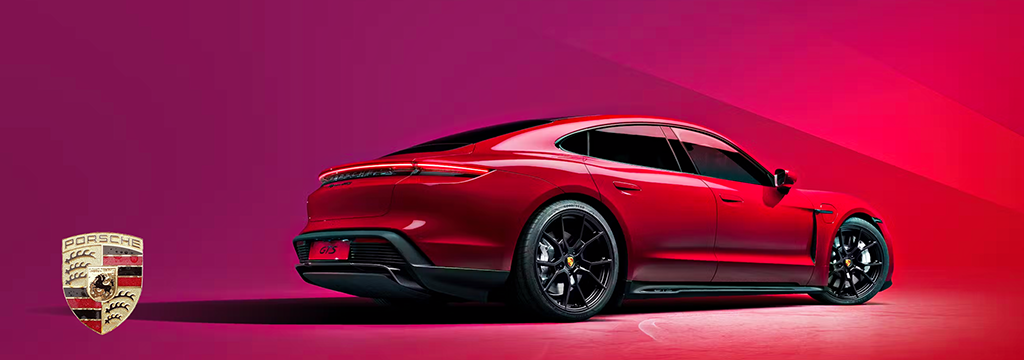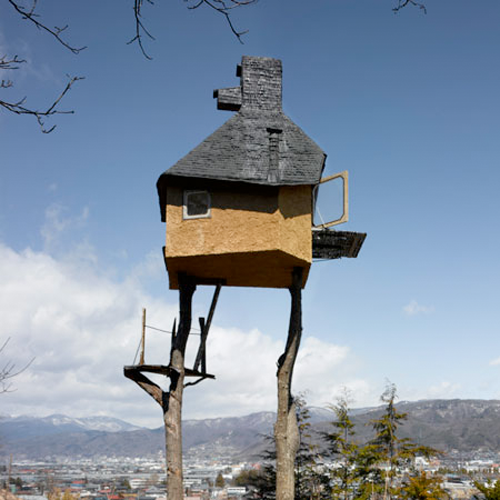Porsche museum.

Vienna architects Delugan Meissl have completed work on the new Porsche Museum in Stuttgart-Zuffenhausen, Germany. The museum opens January 31, 2009.
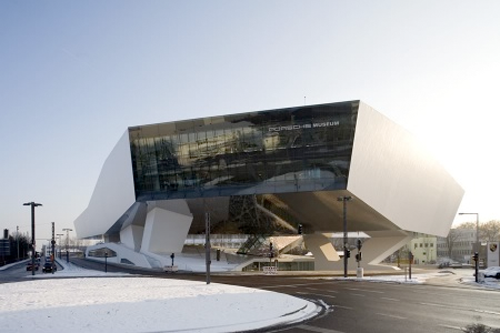
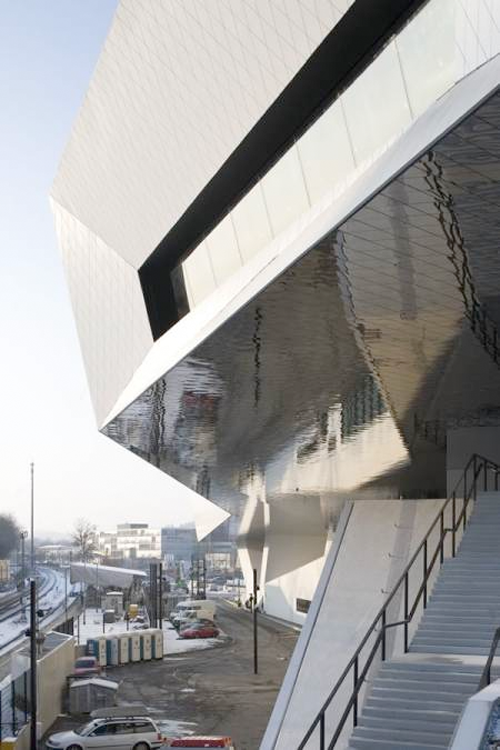

The museum will house around 80 chronologically-arranged vehicle exhibits and will be routinely replaced by other historical Porsches, as the majority of the exhibits can be driven on the road.
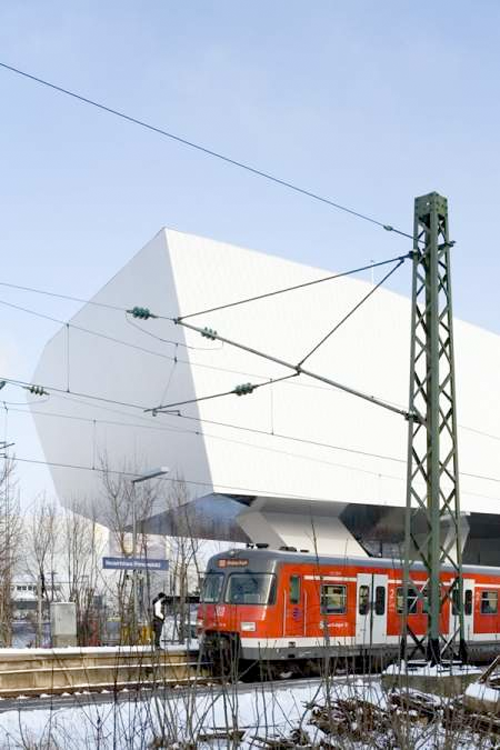
The company’s production and media archives will also be housed on-site, alongside a 3000-book library, shop, restaurant and conference facilities.
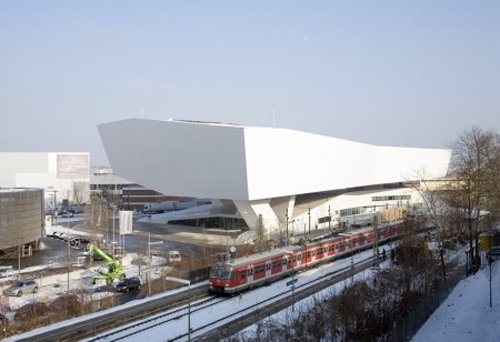
Photos are courtesy of Nathan Willock.
The following is from Porsche…
The Idea
The successful record of Stuttgart’s sports-car manufacturer – Porsche is both the smallest independent German automaker and the world’s most profitable automaker – is based on decades of experience in automotive manufacturing and in motorsports. The history of Porsche sports cars begins in 1948 with the legendary Type 356 “No. 1,” but the conceptual basis of the brand is the result of the lifelong work of Professor Ferdinand Porsche (1875–1951), which was continued by his son Ferry (1909–1998).
By establishing an independent engineering office in Stuttgart in 1931, Ferdinand Porsche laid the foundations for the House of Porsche, and he made automotive history by pioneering developments for his client companies. During the past six decades, Porsche has experienced many high points as well as low ones. But thanks to efficient production methods, distinctive positioning of its brand, and innovative models such as the 356, 911, 914, 924, 944, 928, and the Boxster and the Cayenne, the former sports-car specialist has developed into one of the world’s most successful automobile manufacturers.
This unique history is both an honor and an obligation. Porsche customers, shareholders, and Porsche fans had often expressed their wish for an inspiring place in which to display the corporate history, and in July 2004 Porsche’s Management Board responded by approving the construction of a new museum at Zuffenhausen’s Porscheplatz. Since October 2005, construction has been underway on a museum that will be an architectural emblem of the Porsche brand and make history as the most spectacular building project ever undertaken by the company. The elaborate new museum will be completed near the end of 2008 and will become the central repository where the Porsche tradition will be preserved and displayed.
The Location
Auto fans around the world know that the traditional site of Porsche AG is in Stuttgart-Zuffenhausen. Seventy years ago the erstwhile Porsche engineering office relocated from downtown Stuttgart to the first, newly built Porsche plant in Zuffenhausen. This is where the trial series of what became the “VW Beetle” was built in 1938, as was the forefather of all Porsche sports cars, the Type 64 “Berlin–Rome Car,” in 1939.
In 1950 this Stuttgart suburb became the birthplace of the sports cars bearing the Porsche logo. Today, the 911 model series and all Porsche engines are produced in Zuffenhausen. And Porsche’s new museum will be located here, on Porscheplatz. At this historic location, it will join the Porsche plant and the Porsche Center as the new emblem of the company.
The Architecture
There’s no doubt about it, even now: the new edifice by Vienna’s Delugan Meissl is an eye-catcher. Although the building isn’t quite finished yet, the fascinating impact of the monolithic, virtually floating exhibition hall can already be felt. This bold and dynamic architecture reflects the company’s philosophy and provides a foretaste of the experience that awaits visitors to the future museum. It is designed to convey a sense of arrival and approachability, and to guide the visitors smoothly from the basement level into the superstructure.
In their design, the architects at Delugan Meissl set out to create a place of sensuous experience that reflects the authenticity of Porsche products and services as well as the company’s character, while also reshaping Porscheplatz with an unmistakable appearance.
The Exhibits
About 80 vehicles and many small exhibits will be on display at the new Porsche Museum in a unique ambience. In addition to world-famous, iconic vehicles such as the 356, 550, 911, and 917, the exhibits include some of the outstanding technical achievements of Professor Ferdinand Porsche from the early 20th century. Even then, the name of Porsche stood for the commitment never to be satisfied with a technical solution that fails to fully meet or exceed all of its requirements, including opportunities for further improvement.
From the lobby, visitors ascend a spectacular ramp to the entrance of the spacious exhibition area, where they can gain an initial overview of the impressive collection.
Here the visitor is free to choose whether to start chronologically with the company history before 1948, or to head directly into the main area of the exhibition, which contains a chronological history of Porsche products and thematic islands. Both areas are interlinked by the “Porsche Idea” section, which forms the backbone of the exhibition.
The Idea section explains what makes the various themes and exhibits so unique. It tells of the spirit and the passion that motivate the work at Porsche, and pays tribute to the company as well as the people behind the product.
Concept
The new museum enlightens the visitor in an impressive, clear, and interesting manner about the entire history of what is now Dr. Ing. h.c. F. Porsche AG. Production cars have been just as important to the name recognition of the Porsche brand as many vehicles designed specifically for racing. Porsche designs have had an impact on individual mobility even in the early years of motorization.
The exhibition layout provides separate exhibit areas for the two periods before and after 1948. “Porsche Idea,” “Product History,” and “Thematic Islands” are the three core elements of the museum concept. Visitors making their way through the exhibition will often find these three main elements thematically interlinked.
The “Porsche Idea“ section focuses on specific, trailblazing technical solutions for interesting challenges from nearly all areas of mobility. Visitors can learn about the values, motivation, and philosophy driving the company throughout its history and to its ultimate success.
The “Product History” section is a chronologically arranged presentation of the history of Porsche sports cars from its beginnings in 1948 to the latest models with all their technological diversity and stylistic individuality.
“Thematic Islands” focus on particular, especially important aspects of Porsche history. Some of them, like “Evolution 911,” are dedicated to specific model series. Others bring together vehicles from different eras, for example in the splendid motorsport history of “Le Mans.”
The Racing Cars
Unlike many other museums, the new Porsche Museum stands for joie de vivre and variety. It will continue to remain committed to the long-established philosophy of the “Museum on Wheels” and will utilize, enhance, and expand the newly assembled collection in Zuffenhausen.
Next year, for instance, the 550 A Spyder will participate in the Mille Miglia, and the 356 Carrera Abarth GT will travel all the way to Australia for the Classic Adelaide.
Instead of a conventional, static exhibition, newly arranged object combinations will create an ever-changing display that reflects the self-image of a company that incorporates both a great tradition and great innovations.
With the “Museum on Wheels” Porsche is taking a route no one else has traveled. Even the classic vehicles in the museum’s collection are serving the purpose for which they were built in the first place: driving!
The Porsche Archive
A central repository is being created in the new museum where all of the historical and contemporary knowledge about the subject “Porsche” is being consolidated. The historical archive of Porsche AG is also moving into the new edifice, where portions of it are visible through glass walls from the lobby.
As the company’s “memory,” the Porsche Archive collects all important information concerning business, technical, social, or cultural matters relating to Porsche AG and its subsidiary companies. The archived items include anything worth saving about the unparalleled Porsche success story, from the beginnings of Ferdinand Porsche as an automobile designer to the engineering office established in 1931 all the way to today’s Porsche AG. The present files of the Porsche Archive cover 2,000 meters of shelf space, including bookshelves, display cases, steel cabinets, and safes.
The Historical Archive with its accumulated knowledge is available not only to internal departments but also to external users, such as journalists and scientists. Many thousands of inquiries annually are handled here in a professional manner by the Porsche archivists.
Designer: Delugan Meissl
Producer: Porsche
via dezeen
Ten wind turbines.
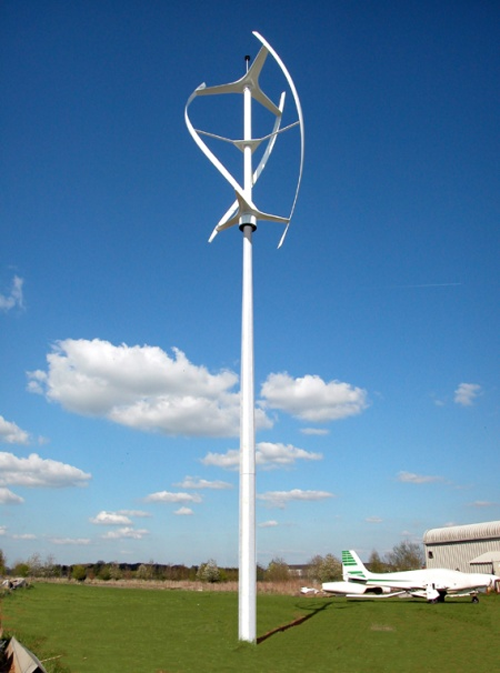 If wind turbines are a turn-on for you… (more…)
If wind turbines are a turn-on for you… (more…)
Modern water fountains.

Some water fountains are really people magnets. Observing human interaction, the kinetic creativity of the Jaume Plensas fountain in Chicago the past three years has inspired this post.
( above ) designer, jaume plensas, chicago, USA. water and digital video.

( above ) designer, armand vallancourt, san francisco USA. concrete tubing.
( above ) fountain clock, kanazawa JP. fountain clock.
( above ) designer, unknown, location unknown. the waterboard, not exactly a fountain.

( above ) designer, lotta hannerz, paris, FR. water mobile venus.

( above ) designer, unknown, seattle US. variable pressure fountain.

( above ) designer, unknown, zacatecas MX. a fountain inside a silver mine.

( above ) designer, william pye, sunderland UK. water vortex.
Is there a difference between an older, more traditional fountain vs modern? Do you have a favorite you frequent or fond memories of one?
Splashy trash.


Whether or not you must throw your trash on the street, what about pink and white polka dot designer trash bags? Or Anycoloryoulike?
Each bag is biodegradable and treated with repellent for even rodents of unusual size. Though this is a New York City art intervention initiative, you can splashy trash in your town too.
via momeld
Middle colors humidifier.
For many of our readers, winter is just around the corner. And that may mean it’s time to trade the A/C unit for a humidifier. Here is a cute one.
Designed by Takashi Hiroshi Tsuboi, the tear-drop shaped humidifier is ultrasonic and can produce moisture for up to ten consecutive hours. If you speak Japanese or knows someone who does you are in luck as they aren’t yet available in the U.S. But it would make a great gift for someone you really care about, and you too!
Designer: Takashi Hiroshi Tsuboi
Producer: Middle Colors
via cool hunting
What was that plant thinking ?

How much brainpower does it take to blog? I know! Let’s ask a plant! Well, it seems that’s possible in Japan where a plant has
been wired wired with sensors that pick up bio-electrical signals and converts the signals into data that’s then translated into Japanese. Are you following this?
A typical entry? “It was cloudy today. It was a cold day.” Sounds like the plant could Twitter.
It’s a university engineer’s project about communicating with plants. Let’s do the right thing here and point this engineer to Facebook.
See for yourself at plant blog
25 inspirational pumpkin carvings.

Check out twenty-five crafty carvings.
oh, yes, the obligatory political pumpkins …
via designobserver

Chicago Spire not spared.
 Another USA financial crisis casualty. This bit of news not about Joe the plumber. On the contrary, it’s an example of the very wealthy feeling it. Make you feel better? Probably not.
Another USA financial crisis casualty. This bit of news not about Joe the plumber. On the contrary, it’s an example of the very wealthy feeling it. Make you feel better? Probably not.

Architect Santiago Calatrava is in the news suing the developer of the Chicago Spire.
Mary Ellen Podmolik and Blair Kamin, Chicago Tribune reporters spell it out.
“The Chicago Spire’s penthouse may be sold but there is growing doubt whether the project will rise out of the hole that’s been created at 400 N. Lake Shore Drive.
Consultants on the project are starting to line up seeking payment for their work on the development, designed to become the tallest skyscraper in the United States and one of the tallest in the world. The most well-known of the consultants, architect Santiago Calatrava, filed a lien on Oct. 8 through his Lente Festina Ltd., seeking more than $11.3 million in payment from Spire developer Shelbourne Development Group Inc.
Separately, Chicago-based architectural design firm Perkins+Will Inc. filed a lien against Shelbourne for almost $4.85 million in payment. The two liens were filed with the Cook County recorder of deeds.
The liens suggest the project’s financing, as well as its feasibility, is shaky.”
Recently, Donald Trump was in town to top off his 92-story Trump Tower. Here is an excerpt from the Chicago Tribune
DA editor’s note: Struggles of this scale and stature have not happened very often in the U.S. In other parts of the world it may be more commonplace. One enjoyable and very enlightening exhibition I attended at the Art Institute of Chicago was on Russian architecture. All the buildings on display were never built! Things were ( are? ) so bad in Russia at the time that the frustrated architects, who never could get funding, had competitions of concepts only. The guest architects laughed about the great deal of vodka drinking and story-telling taking place at these competitions. Creative therapy in action.
Let’s hope everything works out in the end. From a design perspective, Chicago would like to see a Calatrava somewhere in town – his work, inspirational. If it has to be utilitarian in this economic environment the city has many needy bridges. Until then, the Milwaukee Art Museum, an hour away, will not disappoint, especially at sunset when the “wings” unfurl.

( above ) Image found one week after original post: dynamic architecture next big thing! Inspiration strikes in the most unlikely places.
more information via chicago tribune wikipedia chicago spire
The Laptop. Underground stadium.

We’ve seen the splendor of China’s Bird’s Nest, now check out a new contender for the prize of most unique stadium. The stadium design by MZ & Partners Architects has already earned the nickname “The Laptop.” The main stand is upright with most of its height coming from the underground field. All lights will be embedded in the surrounding architecture of the stadium. It is hoped that the underground stadium will help keep the players and spectators cooler. It is expected to be completed in 2010.

If all goes to plan, ‘The Wall’ stadium in Doha, Qatar’s capital city, will claim two firsts: The world’s first underground stadium and the world’s first open-air, air-conditioned stadium. There’s a long way to go however and the stadium is not due to be completed untl 2010 at the earliest, however if the finished product looks anything like the plans released by MZ & Partners Architects then paying spectators are in for a treat.


After looking at the stadium from above you can immediately see why The Wall has already gained the nickname ‘The Laptop’. The stadium’s main stand sits upright, the majority of its height emerging from the underground pitch as if having been lifted opened by an enormous referee. There will be no traditional floodlights, a feature the architects seem to be quite proud of, as all lights will be embedded within the surrounding architecture, adding to the stadium’s mystical feel.
So why underground? Obviously it’s a great coup to have the world’s first underground stadium but there’s one invaluable benefit, especially in a climate such as Qatar’s: temperature control. A subterranean stadium should ensure that the pitch and its spectators retain a cool, bearable atmosphere naturally without the need to spend millions of pounds on air-conditioning.
The stadium is apparently part of Doha’s forthcoming bid to host the 2018 World Cup and if the location was decided purely down to stadium architecture, they may have a chance. The one concern? The Wall will only be able to seat 11′000 people.
Designer: MZ & Partners Architects
